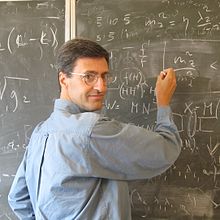Gian F. Giudice
| Gian Francesco Giudice | |
|---|---|
 |
|
| Born |
January 25, 1961 Padua, Italy |
| Nationality | Italian |
| Alma mater |
University of Padua International School for Advanced Studies |
| Scientific career | |
| Fields | Physics |
| Institutions |
CERN INFN University of Texas at Austin Fermilab |
| Doctoral advisor | Riccardo Barbieri |
Gian Francesco Giudice (born January 25, 1961) is an Italian theoretical physicist working at CERN in particle physics and cosmology.
After graduating in physics from the University of Padua in 1984, Giudice obtained in 1988 his PhD in theoretical physics from the International School for Advanced Studies in Trieste. Between 1988 and 1990 he was Research Associate at the Fermi National Accelerator Laboratory near Chicago. Between 1990 and 1992 he was Research Fellow in the Physics Department of the University of Texas at Austin, in the group led by Steven Weinberg. After being employed by the Istituto Nazionale di Fisica Nucleare of Italy, in 1993 he moved to CERN, where he is currently the Head of the Theoretical Physics Department. Academician of the Istituto Veneto di Scienze, Lettere ed Arti and of Accademia Galileiana, he has been awarded the 2013 Jacques Solvay Chair in Physics.
The research activity of Giudice mainly deals with the formulation of new theories that extend our present knowledge of the particle world toward even smaller distances. He is also studying how these theories can be applied to cosmology in order to describe the early stages of the history of our universe. His most notable results are in the areas of supersymmetry, extra dimensions, electroweak physics, collider physics, dark matter, and leptogenesis. Together with physicist Riccardo Barbieri, he proposed a widely used criterion to test the degree of naturalness of a supersymmetric theory that achieves electroweak symmetry breaking. He co-invented the Giudice-Masiero mechanism, which is the leading explanation for the Mu problem of supergravity. He has made fundamental contributions to the construction of Gauge Mediation, and he is a co-author of the first papers proposing Anomaly Mediation and Split Supersymmetry. He is one of the proponents of a method to compute quantum effects in theories with broken supersymmetry through analytic continuation into superspace. Well known and much used in LHC studies is his method to describe graviton interactions in theories with extra spatial dimensions. He is also one of the originators of the idea of Minimal Flavor Violation, a paradigm to characterize the effects of flavor transitions in new theories of particle physics. After the discovery of the Higgs boson, he computed the probability that the Higgs vacuum undergoes quantum tunnelling, finding the surprising result that the universe is in a critical state which will eventually end in a cosmic collapse.
...
Wikipedia
